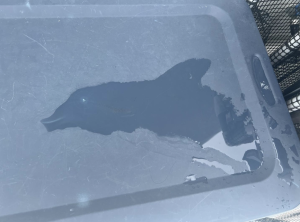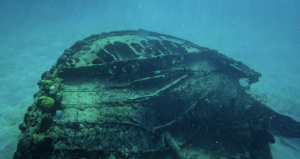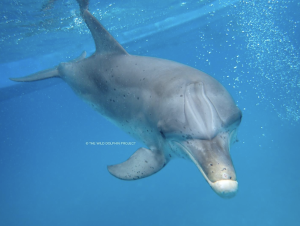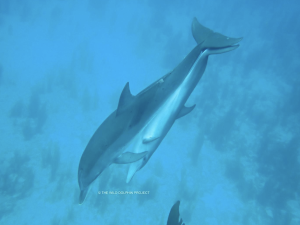On The Hunt in LBB
Hello! We’ve just wrapped up our fifth trip of the summer, and it’s hard to believe that the field season is nearing its end. Trip 5 was truly special as we had renowned ecologist and author, Carl Safina, aboard the Stenella. Carl, who was also our speaker at the 2023 Wild Ocean Science event, regaled us with tales of his thrilling adventures and shared captivating videos from his travels.
As with our previous trips this summer, we began our journey on Little Bahama Bank (LBB). While we didn’t encounter any of the LBB dolphins this time, we’re optimistic about spotting them on Trip 6. Despite not seeing our dolphin friends, we enjoyed calm, clear waters which made for an easy day of surveying. We were not as lucky when we crossed to Bimini, and the seas kept us rockin’ and rollin’ for a few hours. However, we soon reached Bimini, where we enjoyed sunny skies and waves in our search for the Great Bahama Bank (GBB) dolphins. As we began searching, our first mate stumbled across a little sign saying dolphins were in our future.
 Our sign that dolphins were coming. A dolphin shaped puddle of water on the camera rinsing bin. (Photo by First Mate Andrew Symonds)
Our sign that dolphins were coming. A dolphin shaped puddle of water on the camera rinsing bin. (Photo by First Mate Andrew Symonds)
Beautiful Skies in Bimini
While we would love to say that we find dolphins every day, they are wild animals, and they’ll win the game of hide and seek every time! It took a day or two on GBB before we finally spotted some dolphins. Along the way, we made a refreshing stop at the Hesperus wreck for a quick snorkel. The Hesperus is a small, shallow wreck that is teeming with fish and conch and is always a passenger favorite.

Hesperus Bow (Photo by First Mate Andrew Symonds)
Finally, our patience paid off, and we had a great first encounter with Nautica, Spring, and Oreo. Nautica, one of Nassau’s daughters, is known for her curiosity and playful nature. We had a blast playing with sargassum as the dolphins dove and whistled all the while. The three juvenile females kept us on our toes, swooping in to drop sargassum in front of us and then snatching it away before we could grab it. If we were lucky, we were able to grab the sargassum and drop it for the dolphins, but sometimes, we humans are just too slow, and it becomes a big game of keep away (especially when Nautica is involved). We saw Nautica a few times this trip, and each time she was just as playful as the last. Usually, she tries to instigate some little fights amongst the calves, but this trip she was more interested in playing with the people. It was an amazing encounter, and our passengers were ecstatic afterwards, especially since this encounter broke our dolphin dry-spell.

Nautica coming to say hello. (Photo by Allison Sanchez)
Close Encounters with the Males & Courtship Behaviors
Later in the trip, we encountered a group of four males: Zeke, Lamda, Trident, and Evren. Usually, the male dolphins tend to leave us in the dust, however, this group stuck around, buzzing our fins and surfing the waves before we gave them a bow ride. We loved getting to see Lamda! He is the dolphin who was found live-stranded in 2018, and with our help and the help of a Bahamian animal rescue, he was safely rehabilitated and released back with his pod. He remains quite friendly with us in the water, and it is always great to see him doing well! See the full story here: https://www.wilddolphinproject.org/lost-lamda/. Towards the end of the trip, we were fortunate to have a few encounters with some mom-calf pairs and pregnant females. Nautica also happened to be part of this group, and she was pursued by Nemo (Nereide’s recent male calf) and Banshee (Bishu’s recent male calf), as they practiced courtship and mating behaviors. Although male spotted dolphins reach sexual maturity at around 15 years of age (when they enter the Fused color phase), these activities are typical for young males. They even practice mating and courtship behaviors with their mothers and other females (of any age)!
Nemo (below) practicing courtship with Nautica. (Photo by Allison Sanchez)
Bottlenose Crater Feeding
We were also fortunate to witness not one but two bottlenose dolphin crater feeding encounters—a rare sighting as the bottlenose are less tolerant of people and like to enter what we call “the magic escape portal” when they see our boat. Crater feeding is a unique feeding technique that the bottlenose use to hunt their prey. They scan the sandy bottom and use echolocation to find creatures like razor fish and their favorite, conger eel. Then they flip upside down and dig their head into the crusty sand until they’ve caught their meal. They sometimes dig as far as their pectoral fins! Once done, this process leaves behind a crater in the sand, hence the term “crater feeding”.

A bottlenose dolphin crater feeding for conger eel. (Photo by Hayley Knapp)
Overall, it was a fantastic trip despite some rather blustery days. Fieldwork is always an adventure with its unpredictable weather, and dolphin behaviors, and this trip was no exception. The interactions we did have were rich in behavior and acoustic activity. We are so thankful to call the Bahamas our summer home. As we rapidly approach the end of the field season, we are crossing our fingers and fins for pleasant, calm weather and, of course, more dolphins.
Until next time!
Hayley Knapp and Allison Sanchez

